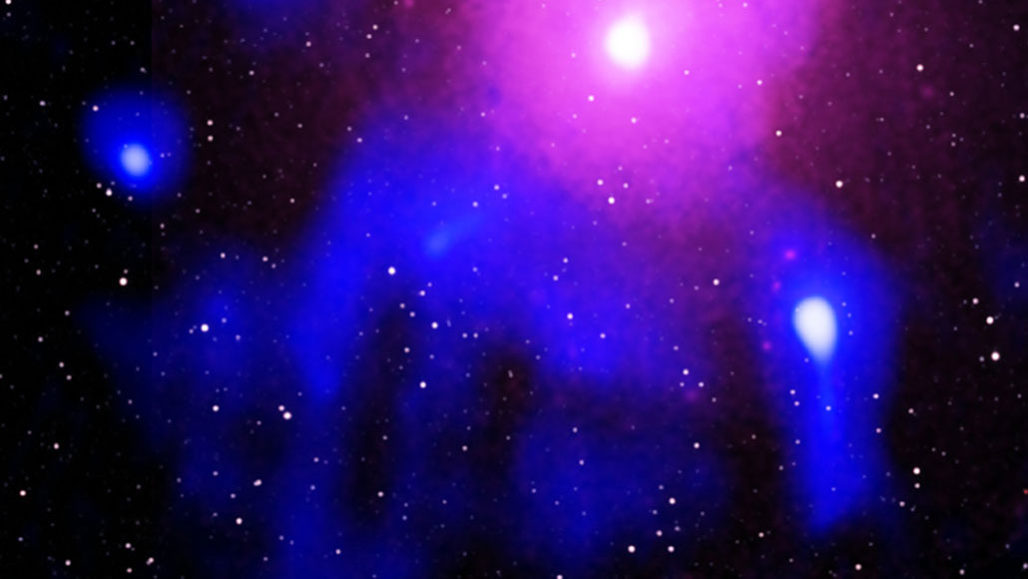astrophysicist: A scientist who works in an area of astronomy that deals with understanding the physical nature of stars and other objects in space.
Big Bang: The rapid expansion of dense matter that, according to current theory, marked the origin of the universe. It is supported by physics’ current understanding of the composition and structure of the universe.
black hole: A region of space having a gravitational field so intense that no matter or radiation (including light) can escape.
colleague: Someone who works with another; a co-worker or team member.
electron: A negatively charged particle, usually found orbiting the outer regions of an atom; also, the carrier of electricity within solids.
eruption: (in geoscience) The sudden bursting or spraying of hot material from deep inside a planet or moon and out through its surface. Volcanic eruptions on Earth usually send hot lava, hot gases or ash into the air and across surrounding land. In colder parts of the solar system, eruptions often involve liquid water spraying out through cracks in an icy crust. This happens on Enceladus, a moon of Saturn that is covered in ice.
galaxy: A group of stars — and usually dark matter — all held together by gravity. Giant galaxies, such as the Milky Way, often have more than 100 billion stars. The dimmest galaxies may have just a few thousand. Some galaxies also have gas and dust from which they make new stars.
galaxy cluster: A group of galaxies held together by gravity. Galaxy clusters are the largest known objects in the universe.
intergalactic: An adjective that describes some position between galaxies.
Krakatoa: A volcano in Indonesia (known as Anak Krakatau) that in 1929 rose above the sea to form an island at the site of Krakatau, or Krakatoa (a volcano that erupted violently in 1883, sending shock waves and ash around the world). Anak Krakatau emerged above sea level in 1929. It had been growing ever since. In December 2018 it erupted, losing much of its cone and rocky mass. This event also triggered an underwater landslide, which caused a tsunami that killed more than 400 people.
light-year: The distance light travels in one year, about 9.48 trillion kilometers (almost 6 trillion miles). To get some idea of this length, imagine a rope long enough to wrap around the Earth. It would be a little over 40,000 kilometers (24,900 miles) long. Lay it out straight. Now lay another 236 million more that are the same length, end-to-end, right after the first. The total distance they now span would equal one light-year.
radio waves: Waves in a part of the electromagnetic spectrum. They are a type that people now use for long-distance communication. Longer than the waves of visible light, radio waves are used to transmit radio and television signals. They also are used in radar.
speed of light: A constant often used in physics, corresponding to 1.08 billion kilometers (671 million miles) per hour.
sun: The star at the center of Earth’s solar system. It is about 27,000 light-years from the center of the Milky Way galaxy. Also a term for any sunlike star.
telescope: Usually a light-collecting instrument that makes distant objects appear nearer through the use of lenses or a combination of curved mirrors and lenses. Some, however, collect radio emissions (energy from a different portion of the electromagnetic spectrum) through a network of antennas.
universe: The entire cosmos: All things that exist throughout space and time. It has been expanding since its formation during an event known as the Big Bang, some 13.8 billion years ago (give or take a few hundred million years).
volcano: A place on Earth’s crust that opens, allowing magma and gases to spew out from underground reservoirs of molten material. The magma rises through a system of pipes or channels, sometimes spending time in chambers where it bubbles with gas and undergoes chemical transformations. This plumbing system can become more complex over time. This can result in a change, over time, to the chemical composition of the lava as well. The surface around a volcano’s opening can grow into a mound or cone shape as successive eruptions send more lava onto the surface, where it cools into hard rock.
wavelength: The distance between one peak and the next in a series of waves, or the distance between one trough and the next. It’s also one of the “yardsticks” used to measure radiation. Visible light — which, like all electromagnetic radiation, travels in waves — includes wavelengths between about 380 nanometers (violet) and about 740 nanometers (red). Radiation with wavelengths shorter than visible light includes gamma rays, X-rays and ultraviolet light. Longer-wavelength radiation includes infrared light, microwaves and radio waves.
X-ray: A type of radiation analogous to gamma rays, but having somewhat lower energy.








